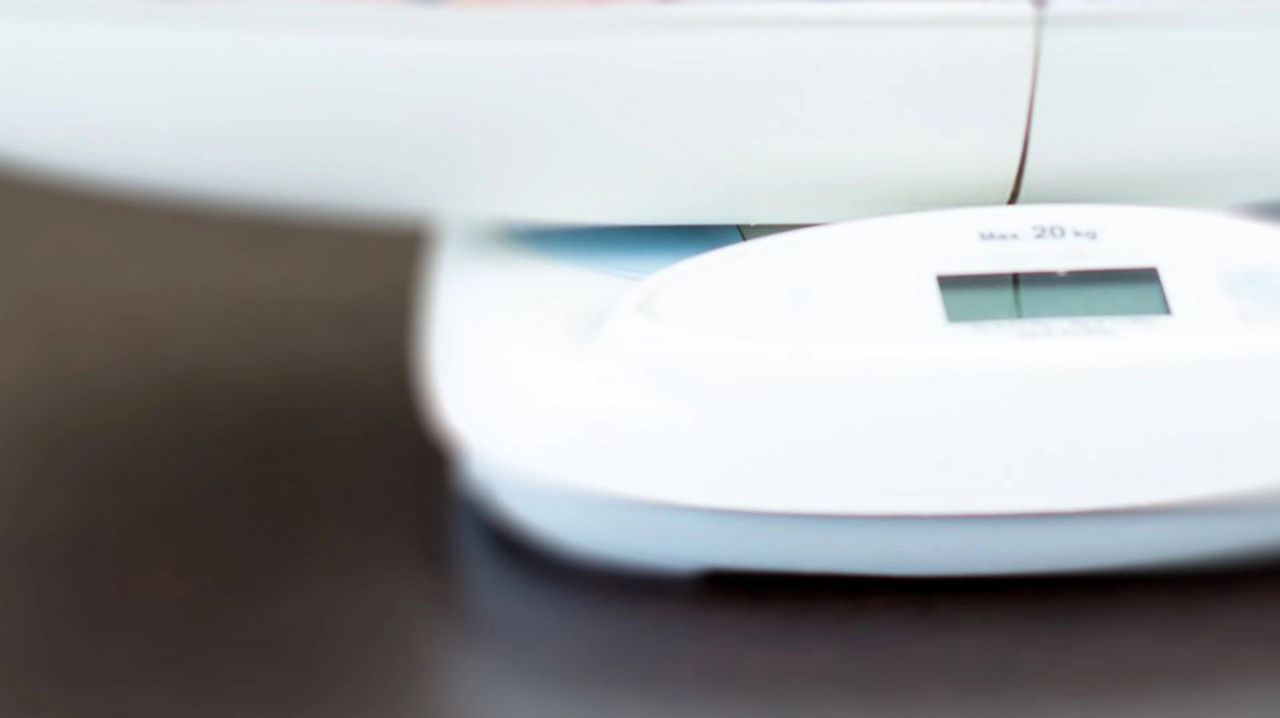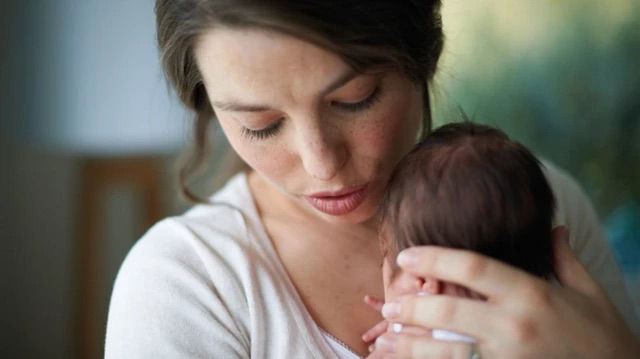Average baby weight
The average weight of a newborn baby can vary greatly. As you navigate your feeding journey, whether your baby is breastfed or formula fed, it’s only natural to want the best for your baby’s health.
Your baby’s growth is an important indicator of your baby’s development and wellbeing, and there’s a lot of information out there about the ‘average baby weight’ and BMI, as well as baby growth charts and percentiles. To provide you with the help and guidance you need, here you’ll find lots of information on everything from the average baby weight and how often they should be weighed, to how much you can expect your baby to grow during their first year.

What is the average baby weight of a newborn in the UK?
During 2019-2020, 84% of babies who had their weight recorded in England weighed anywhere between 2.5 and 3.9kg1 at birth. Only 7% of babies recorded had a low birthweight of less than 2.5kg1.
There are many factors that can influence how much your baby weighs at birth. Your diet and nutrition during pregnancy, whether or not your baby was premature or born after their due date, and the physical build of both biological parents, being just a few examples1.
At the end of the day, babies come in all shapes and sizes, just like their parents, so it’s important not to compare your baby to any others. If you've got any concerns at all about your baby’s weight, always speak to your midwife or GP who will be able to put your mind at rest.
How often are babies weighed?
Your baby is likely to be weighed very soon after you've given birth. Once the midwife has checked that your baby is OK, and after you’ve had some skin to skin contact if that’s what you’ve chosen to do in your birth plan, your baby will be weighed2.
Your baby’s weight and growth will continue to be measured regularly by a healthcare professional from birth. The results will be recorded in your baby’s personal child health record (PCHR), and you’ll probably come to know this more commonly as the ‘red book’. The PCHR contains lots of information about your baby’s growth and development, as well as immunisations and where to seek support if you need it. The PCHR also contains your baby’s weight chart, to make sure your baby’s growth and weight is on the right track.
Exactly how often your baby will be weighed depends on their age. As a general rule of thumb, if there are no health problems or concerns after the first two weeks of your baby’s birth, they should be weighed3:
- Once a month up to 6 months of age.
- Once every two months from 6 to 12 months of age.
- Once every three months over the age of 12 months.
Your baby won’t ordinarily be weighed more regularly than this unless you request this from your midwife, or if there are concerns about your baby’s weight and growth.
It’s very important for you to attend all of your baby’s scheduled clinic appointments, and that you speak with your midwife or GP if you’ve got any concerns at all about your baby’s weight gain, growth and development.
Baby weight loss after birth
It’s completely normal, and expected, for babies to lose weight in the first few days following their birth. Breastfed babies tend to lose anywhere between 5 and 7% of their birth weight, whilst formula fed babies usually lose around 3 or 5%4.
Most babies stop losing weight within three or four days, and in most cases will have regained their birth weight, or weigh more, within three weeks after the birth, as by this point your baby will be getting used to breast or bottle feeding regularly3.
If your baby isn’t back up to their birth weight by this time, or if they lose more than 8% of their birth weight, your midwife or health visitor is likely to offer some additional support to help with feeding and baby weight gain4.
How your baby’s growth is measured
Growth and baby weight gain are good indicators that your baby is healthy and thriving. If they’re growing and gaining weight, then that’s a good sign that everything’s as it should be.
Here in the UK, health professionals use the UK-WHO (World Health Organization) growth charts. Although based on breastfed babies, the World Health Organization charts are used for all babies, even if they’re formula fed. Take a look below.
Your baby’s weight chart and the baby weight percentile
Baby weight and growth is measured by using what’s known as a centile chart. A centile chart shows the growth pattern that healthy children normally follow, irrespective of whether they’re breastfed, formula fed or a mixture of both.
There are different charts for boys and girls. That’s because in general, boys tend to be a little heavier and have growth patterns different to those of girls. Babies who are born before 37 weeks of pregnancy will follow a different chart until two weeks after their original due date. After that, the standard boy/girl charts will be used, applying a correction factor5.
The baby weight chart is a guide to your baby’s very own individual weight gain. Each baby will have their own growth chart in their red book, and three of the things that may be measured are weight, length, and the circumference of your baby’s head. The chart also has a BMI converter5.
Baby weight charts - what does it all mean?
The growth centiles on a baby weight chart show the average weight gain for babies of different ages, with the 50th percentile being the average (median) for the population. You’ll recognise them as the curved lines on the chart in your red book.
Don’t be too concerned if your baby starts off at the top or the bottom end of the baby weight chart - this doesn’t mean they are over or underweight.
Remember, however much your baby weighs, it’s their growth between appointments that your healthcare professional will be looking for.
What your health visitor will look for, in between appointments, is a steady rate of weight gain along your baby’s centile on the growth chart. This is individual to them. Your baby’s weight and height may not follow the same centile line all the time, and that’s OK, as it’s not unusual for the measurement to go down or up by one centile3.
However, if your baby’s measurements change by two centiles, this is less common. If that happens, it’s probably worth discussing this with your doctor or health visitor in order to rule out any underlying health issues.
Remember that all babies are different – even siblings. Try not to compare your baby to others and focus on enjoying how much they’re growing and changing every day.
Growth charts can be overwhelming and sometimes, confusing. The main thing to remember is that if your doctor is happy with your baby’s growth and weight gain, there’s nothing for you to be concerned about.
How much weight should a baby normally gain?
You’ll see your baby grow most rapidly in the early months of their life, a theme that will continue throughout their first year.
By the time they’re six months old, your baby is likely to weigh twice as much as they did at birth. Usually, your baby will gain most of their weight between six and nine months of age. Their growth will then gradually slow down, as they become more active as toddlers.
Your baby may gain less weight when they’re ill or teething.
Occasionally, your baby’s weight may increase or decrease at a higher rate than it normally would. This could be caused by a sudden growth spurt or a bout of illness. Your baby's weight can also fluctuate once they start weaning, when they may have difficulty accepting solids, or when they become more mobile, and their activity levels increase.
A general trend of good weight gain is a sign that your baby is growing well and meeting their early milestones for a lifetime of healthy development. If you have any concerns about your baby's weight gain, talk to your health visitor.
What if my baby isn't gaining weight
If your baby isn’t gaining weight, then this can sometimes be a sign that there’s a problem. That’s why your baby’s weight will be carefully monitored during the first couple of months after their birth, to make sure that they’re developing healthily and growing as they should.
Rest assured that if your baby loses weight or isn’t back up to their birth weight within a certain time frame, your midwife or health visitor will be on hand to provide help, advice and support.
Related articles

Need some help?
You can get quick answers to common questions in our FAQs.
Alternatively, if you need help with general pregnancy or baby advice, or maybe on using or ordering our products - our expert team are always on hand to talk about feeding your baby.
- National Health Service (NHS). NHS Maternity statistics, England 2019-20 [Online]. 2020. Available at: https://digital.nhs.uk/data-and-information/publications/statistical/nhs-maternity-statistics/2019-20/births. [Accessed September 2023]
- NHS. What happens straight after the birth? [online] 2022. Available at https://www.nhs.uk/pregnancy/labour-and-birth/after-the-birth/what-happens-straight-after/. [Accessed September 2023]
- National Health Service (NHS). Your baby’s weight and height [Online] 2023. Available at: https://www.nhs.uk/conditions/baby/babys-development/height-weight-and-reviews/baby-height-and-weight/. [Accessed September 2023]
- NHS Sherwood Forest Hospitals NHS Foundation Trust. Neonatal weight loss in the first 6 weeks [online] 2021. Available at https://www.sfh-tr.nhs.uk/media/11934/pil202109-01-nwl-neonatal-weight-loss-in-the-first-six-weeks.pdf. [Accessed September 2023]
- RCPCH. Growth charts - information for parents and carers [online]. Available at https://www.rcpch.ac.uk/resources/growth-charts-information-parents-carers. [Accessed September 2023]



?ts=1701285595274&dpr=off)